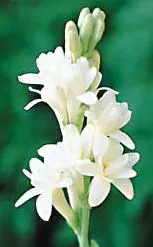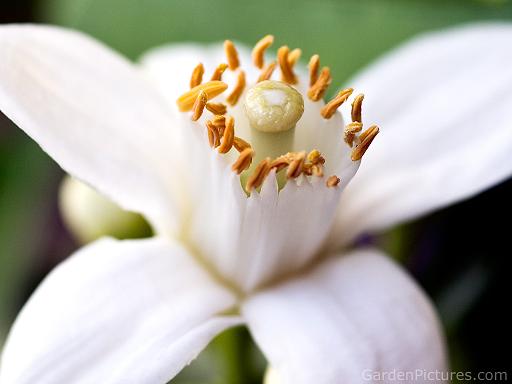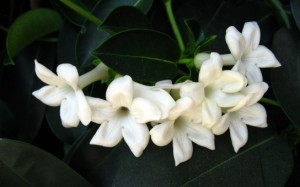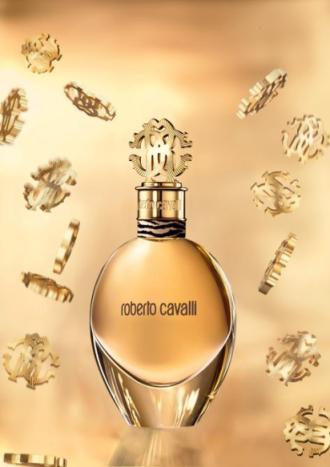Ethereal, glittering, radiant, voluptuous clouds of white with a tiny sliver of a dark lining of funk. That’s Serge Lutens‘ Fleurs d’Oranger, a powerful bouquet of white flowers headlined by orange blossoms and tuberose. It is an eau de parfum created by Lutens’ favorite perfumer, Christopher Sheldrake, and released in 2003.
Serge Lutens describes Fleurs d’Oranger in terms of emotional responses, which seems quite appropriate for such a sensuous fragrance:
It’s within us.
A single whiff of this fragrance, drawn from the highly scented blossom of the bitter orange tree, augmented by a hint of civet, resonates within us.
The notes — as compiled from Luckyscent, Fragrantica and that statement — include:
Orange blossom, white jasmine, Indian tuberose, white rose, citrus peel, hibiscus seeds, cumin, nutmeg and civet.
Fleurs d’Oranger opens on my skin with the most beautiful, concentrated, powerful, and completely narcotic burst of orange blossoms. They are quickly followed by tuberose with a slightly metholated, minty, just barely camphoraceous undertone, and by a powerful heaping of cumin. The latter is a discordant feature in the white mix, radiating a definite aroma of stale sweat body aroma that is quite strong at first. Thankfully, however, it softens, weakens and recedes in less than twenty seconds, retreating just to the periphery, and never returning to the same levels again.
 The tuberose is quite the diva in Fleurs d’Oranger. It repeatedly tries to muscle aside the orange blossoms, and to take over the whole show. It’s brawny, potent, heady, narcotic, indolent, addictively sniffable for those who love tuberose, and the living nightmare of those who don’t. I happen to adore tuberose, and it’s one of my favorite flowers (if not my favorite), so I’m rather in heaven. It’s especially lovely here in Fleurs d’Oranger, as it is simultaneously a little bit green and airy, but, also, full-blown, lusciously languid, creamy, rich and completely voluptuous. It brings to mind what the legendary nose, Roja Dove, once said about tuberose (in the context of the famous, white floral powerhouse, Fracas):
The tuberose is quite the diva in Fleurs d’Oranger. It repeatedly tries to muscle aside the orange blossoms, and to take over the whole show. It’s brawny, potent, heady, narcotic, indolent, addictively sniffable for those who love tuberose, and the living nightmare of those who don’t. I happen to adore tuberose, and it’s one of my favorite flowers (if not my favorite), so I’m rather in heaven. It’s especially lovely here in Fleurs d’Oranger, as it is simultaneously a little bit green and airy, but, also, full-blown, lusciously languid, creamy, rich and completely voluptuous. It brings to mind what the legendary nose, Roja Dove, once said about tuberose (in the context of the famous, white floral powerhouse, Fracas):
tuberose is the most carnal of the floral notes. It smells like very, very hot flesh after you’ve had sex — that’s the bottom line. [via The Independent, 12/14/2002.] [Emphasis added.]
That carnality is in full sway in Fleurs d’Oranger, where tuberose is joined by its similarly voluptuous siblings, orange blossom and jasmine. It’s all because of the indoles, which are present in the three flowers and which are the main reason for Fleurs d’Oranger’s headiness.

Bee on a tuberose. Photo: faixal_javaid via Flickr. http://www.flickr.com/photos/faixal_javaid/3360386339/
The scientific story about indoles, in simple terms, is that bees can’t see white flowers like tuberose, jasmine, orange blossom, gardenia, or the like. So the flowers have an extra-large amount of a natural organic substance called indoles that they put out to signal the bees to their presence. In their undiluted, purest, and most concentrated form in perfumery, indoles can smell like musty mothballs. However, when diluted to just a few drops, they create a radiant richness in floral perfumes that is sometimes described as narcotic, heady, meaty, dense, voluptuous or sensuous. For some, very indolic flowers can have an over-blown, ripe quality that smells sour, plastic-y, fecal, urinous, or reminiscent of a cat’s litter box. Its richness in classic, very opulent fragrances is probably why some people find indolic fragrances to smell “old lady-ish” (a term I hate, by the way, even apart from its ageist aspects). Those who prefer clean, fresh scents are likely to struggle with indolic fragrances as well, and not only because of their heavy feel.
Fleurs d’Oranger contains three of the most indolic flowers around — tuberose, jasmine, and orange blossoms. Here, however, the thickness of the notes is largely undercut by a very subtle, very quiet, green, chilly note underlying the tuberose. It’s all due to methyl salicylate, the revolutionary, transformative key to Lutens’ famously difficult, Tubéreuse Criminelle, and something which is present to a significantly lesser extent in Fleurs d’Oranger. Methyl salicylate is a natural organic compound found in tuberose (and in jasmine) which has a crisp, medicinal, almost mentholated, sometimes eucalyptus-like smell that evokes “Vicks Vapor Rub” for a few, but minty, spearmint mouth wash for others. It can also create varying impressions of gasoline/petrol, rubber, or leather.
The aroma is not a usual part of most tuberose perfumes, but Christopher Sheldrake like to deconstruct the flower to its scientific essence and core molecules in order to emphasize that metholated side. One reason, perhaps, is because it undercuts some of the richness of the flowers’ indoles, thereby assuring a greener, lighter, airier scent that isn’t so overwhelmingly buttery. That’s what happens in Fleurs d’Oranger where Sheldrake cleverly uses the smallest hints of chilly, cool freshness to cut through the heady fumes of the flowers, thereby reducing any potential cloying over-ripeness.
On my skin, Fleurs d’Oranger is primarily an orange blossom scent, always trailed very closely by the tuberose. In the opening moments, sitting in the background as quiet as a wallflower, are the supporting players. There are subtle flickers of zesty citrus peel, feeling more like the slightly bitter oil you get from grating the rind. There is also a barely animalic muskiness, though I never detect civet in its true form, let alone in any substantial degree. The cumin skulks around the corners, too, sometimes adding a quiet funk to the delicate, florals, sometimes feeling like an amorphous, dry, spicy note. Finally, there is a touch of sweet, dainty rose that does, indeed, feel very white and heady.
Nothing, however, has the remotest chance of competing against the tuberose. Sometimes, not even the titular, purported star of the show itself because there are brief moments when the tuberose completely pushes the orange blossoms aside. The jasmine doesn’t fare any better; it is habitually overshadowed in any concentrated, distinctive way. Instead, she is almost intertwined with the tuberose, having an indirect effect in adding to that drug-like, opulent headiness.
Despite the power of the three white sisters, I’m surprised by the lightweight feel of Fleurs d’Oranger. Don’t mistake my meaning — this is a strong scent, especially up close and in the opening hour. However, it lacks a dense, thick, opaque feel. I’ve read that Fleurs d’Oranger was reformulated, perhaps around 2008, in accordance with the start of the IFRA/EU fascistic regulation of perfume ingredients. One of the targeted notes on their hit list is orange blossom oil, which may explain why tuberose sometimes seems as much a focal point of Fleurs d’Oranger as the orange blossoms. According to one Basenotes thread, the perfume used to be almost syrupy in feel. I’ve never tried the original, vintage formulation, but that description fits with everything that I’ve heard: Fleurs d’Oranger was stronger, deeper, richer, heavier and, according to some, had more orange blossoms in it.
Nonetheless, ten minutes into its development, Fleurs d’Oranger is led by the orange blossoms, then followed by lightly mentholated tuberose atop a base of jasmine with a small touch of very heady rose that seems almost like a tea-rose in its sweetness. There is a strong hint of something else lurking about that I can’t quite place and that feels a little woody and dry. Perhaps the hibiscus seeds? And, taking its place in the rear of the line is the cumin with its nuance of earthy funk. Fleurs d’Oranger doesn’t change much from that primary bouquet, though the tuberose will occasionally take the lead for a few minutes until it falls back to trail behind the orange blossoms. Also fluctuating in strength is a subtle muskiness that infuses all the flowers, covering them with a fine veil of sensuousness. The combination would feel almost erotic in its voluptuous carnality, were it not for the subtle freshness and airiness created by the perfume’s green, chilly, menthol undertones.
Fleurs d’Oranger remains that way until its final drydown, when it smells solely of orange blossoms. There is the faintest flicker of some dry spice lurking underneath, though it’s not really distinguishable as cumin. All in all, Fleurs d’Oranger lasted a brief 3.5 hours in total, and I tested it twice. I never have any luck with the duration of Serge Lutens’ pure florals, and sadly, Fleurs d’Oranger is no exception. The perfume’s sillage starts to drop as quickly as the thirty-minute mark, though it is still so powerful up close that I suspect it will give a headache to those who suffer from the richness of indoles. It becomes a skin scent at the end of the second hour, and feels quite blurry around the edges. I have to admit, I’m hugely disappointed because I’ve always loved Fleurs d’Oranger. I first tested it last year, and quite fell in love with its sensuous, bright radiance. If its powerful projection at the start were matched by at least a moderate longevity on my skin, I’d want a full bottle.
Luckily for everyone else, the votes on Fragrantica indicate many people have considerably better times than I did. There, in the duration rankings, 17 people voted for “long lasting,” 11 for “moderate,” and 8 for “very long lasting.” For the sillage, 20 found it to be “heavy,” 17 voted for “moderate” and 7 for “soft.” I think the potency of the opening hour may explain some of the projection numbers because Fleurs d’Oranger truly did not feel nuclear-tipped like some of the 80s powerhouse fragrances, especially after the first 60-90 minutes. My standards must be skewed, however, because Fragrantica commentators frequently bring up the word “powerhouse,” and talk about just how big it is.
In terms of the scent itself, the reactions on Fragrantica are interesting. A handful of people wonder where the orange blossoms are lurking, as they find Fleurs d’Oranger to be primarily a tuberose fragrance on their skin. On the other hand, one or two posters think Fleurs d’Oranger is the best jasmine fragrance around. For the vast majority, however, Fleurs d’Oranger almost amounts to an orange blossom soliflore with spicy, rich, luxurious depths that “sing of summer.” Clearly, it all depends on skin chemistry as to which flower may dominate. The same holds true for the issue of the cumin, and its strength. It is another reason why Fleurs d’Oranger can be far too much for some people. A lot of people can’t handle tuberose; and a number of people are cumin-phobes. Bring the two notes together, and you have a fragrance that is most definitely not for everyone. Yet, despite that, most people on Fragrantica adore Fleurs d’Oranger, using words like “masterpiece” or “the best orange blossom fragrance around.”
The same is true of the commentators on Luckyscent which, by the way, has perhaps my favorite description for the fragrance:
In a word: masterpiece. There is no other way to sum up Fleurs d’Oranger. This is truly a legend in the Lutens line, the fresh yet decadent scent of an orange grove in full bloom, blossoms falling like rain as a warm breeze swirls the petals in the air. The heady and sweet scents of orange blossom, white jasmine and tuberose are highlighted with a hint of citrus and enhanced with just the tiniest wisps of warm spice to create a perfume that is ever-changing and, once you live with it awhile, you begin to sense its ultra complex nature. Fleurs d’Oranger is a floral fantasy that is even more beautiful than any amount of flowery prose can hope to relay…it’s a rare fragrance that could be worn every day and you’d never tire of it. Gloriously feminine, Fleurs is not “cute” nor is it cloying or overpowering…it’s pure French elegance meets a wild romp in an orange grove, a dream of a perfume that will make you close your eyes, breathe deeply and just…smile.
I think that accurately sums up Fleurs d’Oranger. So, too, does this Luckyscent description from a commentator:
Delicately glittering, this bright scent is reminiscent of the orange grove at Versaille. There is something regal and elegant inherent in its light floral composition that is never overwhelming. I wish that it had more staying power though.
As a side note, two people bring up the L’Artisan Parfumeur orange blossom scent as a point of comparison, though I think they’re referring to the 2007 Limited Edition Fleur d’Oranger and not to Seville à L’Aube. Both posters prefer the Lutens version, adding that it is much longer-lasting as well. Speaking of Seville à L’Aube, I hated it. Passionately. I found nothing remotely appealing, seductive, or sensuous about it. It was revoltingly unpleasant and bracingly pungent at the start, before turning into something unbearably cloying and sickeningly sweet later on. Serge Lutens’ Fleurs d’Oranger is a whole other story. It truly is a beauty, to the point whereby I wonder if I should just suck up the dismal longevity and get a bottle anyway.
Nonetheless, I wouldn’t recommend the scent to everyone. If you despise tuberose or jasmine in even the smallest, most microscopic quantities, then stay away. If your skin chemistry consistently turns either flower into something sour or urinous, the same advice applies. And, if very heady, indolic, floral fragrances are not your cup of tea, then run away. But if you have some tolerance for either tuberose or jasmine, and if you love orange blossoms, then I would really give Fleurs d’Oranger a test shot. I think it’s incredibly wearable and versatile, suitable as much for everyday use as it would be for a romantic date night. However, I urge extreme caution in application if you work in a conservative office environment. Do not spray with reckless abandon, or you may have some sensitive coworkers up in arms. Finally, the fragrance is easily accessible and often massively discounted at a number of online retail sites, one of which offers it for the incredibly low price of $69 instead of the usual $120.
The one potential problem that I see with Fleurs d’Oranger is that the average man may find it to be too feminine in nature. I personally don’t believe in gender differentials, and I know a lot of men who wear both orange blossom and tuberose fragrances. In fact, one of my best friends rocks “Carnal Flora” (as he calls the Frederic Malle tuberose fragrance), and his husband finds it utterly irresistible on him. I’m going to strongly insist that he add Serge Lutens’ Fleurs d’Oranger to his collection; it’s a whole other sort of carnality that should be completely up his alley. So, if you’re a guy who is tempted by Fleurs d’Oranger or who likes heady floral scents, don’t get put off by the potential “feminine” categorization and try it. If you can wear Tom Ford‘s Neroli Portofino, Seville à L’Aube, or Vero Profumo‘s Rubj, you can certainly wear Fleurs d’Oranger!
In short, for those who fall in the narrow categories listed above, I definitely recommend this glitteringly bright, voluptuously sensuous, narcotic, white floral cocktail.







